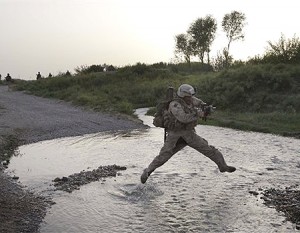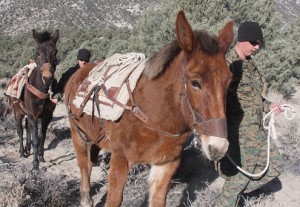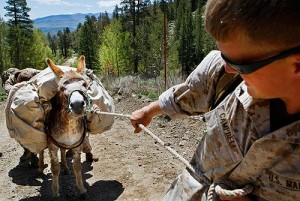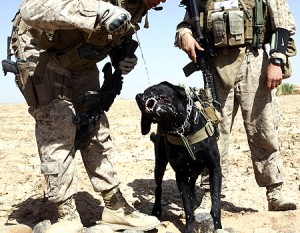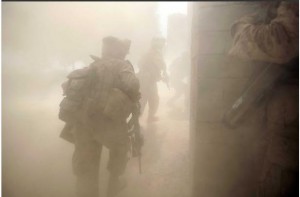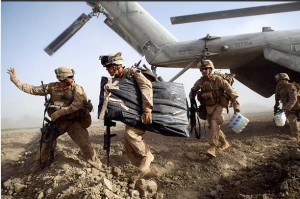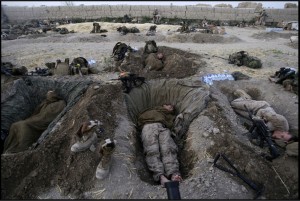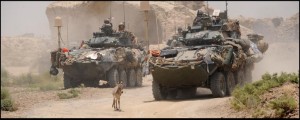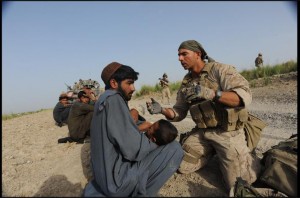Squad Rushes in Afghanistan
BY Herschel SmithI have always been a bit puzzled about the debate over training for counterinsurgency. Other than the bifurcation of the armed forces into Leviathan – Sysadmin as per Thomas P.M. Barnett (a move which I oppose), and without any concrete recommendations for exactly how the COIN proponents would revise or amend the training or organizational structure, the suggestion remain vacuous. We have nothing to evaluate. But conventional tactics remain important.
LAKARI, Afghanistan — Marines with Company F, 2nd Battalion, 8th Marine Regiment, Regimental Combat Team 3, along with the Afghan National Army conducted an early-morning raid on the bazaar.
“The purpose of the raid was to disrupt freedom of movement with the bazaar and to exploit the enemy force logistic base,” said Capt. Junwei Sun, commander, Co. F, 2/8. “This seizure means we invaded Taliban territory, discovered their caches, disrupted their log operations and squeezed them out of the area.”
The Taliban used the open-air market to store mass quantities of drugs, homemade explosives and precursor weaponry. Taliban insurgents also tax shop owners as a further means to make cash. Agents with the Drug Enforcement Agency flew in shortly after the Marines and ANA began clearing more than 300 structures in the bazaar. They seized approximately 270,000 pounds of poppy seeds, 33 bags of opium, 13 bags of hash, nearly 50 barrels of precursory explosive materials, bolt-action rifles and more than 20 IEDs. They also discovered 130,000 pounds of fertilizer that could be used for explosives.
One DEA agent said it was a good haul and a very clear message was sent to the Taliban.
“The Taliban needs to realize that this area doesn’t belong to them anymore,” said Sun. “If they choose to fight, they will be killed.”
Clearing all the structures took approximately 12 hours and the Marines had to use explosives to gain entry into some stores. The stores ranged from a barber shop and garage to clothing and household items. Each room was marked to distinguish that it had already been cleared and whether drugs or explosive material had been found inside.
The raid was intended to only last four to six hours but due to the size of the seizure being larger than expected, the Marines set up security positions throughout the bazaar in order to stay overnight. The next morning, a platoon patrolled through and around the bazaar.
Approximately four hours into the patrol, first and second squad were ambushed from a tree line 800 meters across open farmland. Members of 3rd Squad were to the south along the road and canal to Lakari village when shots began firing toward the other two squads.
“This was the first fire fight for most of my guys,” said Cpl. Brian Short, 23, squad leader and a Mount Vernon, Ohio, native. “They did really well.”
Short, a Mount Vernon High School graduate, made maneuvered his squad toward the other two under fire. Jumping over a wide stream, navigating through grapes vines, okra plants and a corn field, Short’s squad spotted the other two squads and the enemy tree line. With the entire platoon supporting each other, the Marines began squad and fire-team rushes to within 300 meters of the enemy position.
“I wasn’t really that scared. I just wanted to destroy the enemy so my guys wouldn’t get hurt,” said Lance Cpl. Shane M. Lantry, a 3rd Squad team leader and Floyd, N.Y., native. “All the training we get really helped.”
Take note of the situation. The Marines, most of them, hadn’t yet earned their combat action ribbon. Taking fire for the first time, they found themselves in the position of doing squad rushes against an ensconced enemy. They did it successfully due to their training.
Other examples abound. At the Battle of Wanat as we have seem, weapons failures (e.g., jamming) contributed to loss of Observation Post Top Side. Clearing jams very quickly under duress is a must-have skill in highly kinetic operations and with the .223 closed bolt system of arms.
It’s true that language training could be much better, and we have discussed the need for improved indigenous language classes prior to deployment. But until some COIN proponent can describe in detail changes he would make to pre-deployment training, the beauty of the situation is that they are training on all of the right things: shooting at ranges, accuracy, clearing jams, rates of fire, fire and maneuver tactics, use of combined arms, and closing with and destroying the enemy, or in this case, squad rushes (the deployment of fire by the SAW gunners while the balance of the fire team advances, until the fire team stops the advance to deploy fire for the SAW gunner or other fire teams to advance, and so on).
As for sitting and drinking chai with the locals – well, that comes naturally. It requires only a little culture training based on one Marines’ experience. Speak to the men, don’t look at their women, keep your promises, and so on. Doing squad rushes is much more complicated to get right, and deadly if you don’t.
